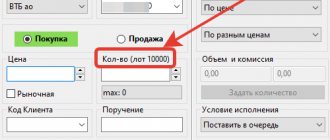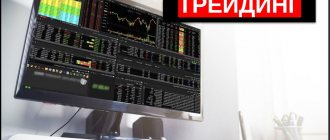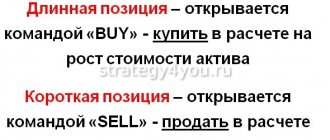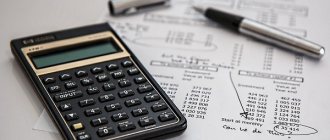The P/E ratio is one of the main multipliers used in comparative analysis of security returns. If the market values the shares adequately, they can be quickly sold and made a profit. In other words, the P/E ratio is a criterion for the investment attractiveness of a company.
Of course, when conducting fundamental analysis, you cannot focus on one indicator. There are other multipliers that represent the same P/E adjusted by some value, for example, by the predicted growth rate. There are also completely different models, more or less accurate: discounting cash flows, comparing graphs with indices, etc.
Today we will analyze the formula for calculating P/E, the role of this ratio in the financial analysis of stock prices, its advantages and disadvantages.
What are multipliers for?
When compiling an investment portfolio, diversification is carried out by economic sectors, countries, currencies and other criteria. Let's say you are choosing between two or more companies from the same sector. How to quickly understand which one to choose? However, you do not have time to study price charts for several years. Moreover, there is no competent specialist in sight, and reading charts is not an easy task for a beginner.
Indicators such as net profit and even the size of dividends will not provide reliable information. All this, of course, should be taken into account, but we must not forget that different companies have different values of assets, number of shares, their value, etc.
For example, the price of one Gazprom share today is 311 rubles, and the cost of Lukoil paper is 6,301 rubles. These two companies represent the same sector – raw materials. How to determine which security is more liquid? This is why multiplier coefficients exist.
Ratios calculated based on financial reporting indicators and current market quotes are a fairly simple method of comparative express analysis. To make a final decision, of course, a more in-depth analysis should be carried out. But after calculating the indicators, at least it is possible to cut off those companies whose values do not correspond to the norms.
Using multipliers, you can calculate the ratio of the book value and market value of securities, the profitability of the company (ratio of profit to revenue), cash flows and other indicators. Today we are looking at one of these ratios – P/E. It shows the ratio of enterprise capitalization and net profit.
What is P/E ratio
The name of the indicator comes from the words Price/Earnings, which literally translates as Price/Earnings. Well, everything is clear with the price - this information is easy to find online. But what constitutes “earnings”, or capitalization, should be understood.
And capitalization is calculated very simply - it is enough to have the financial results report at hand and know how many shares were issued by the issuer. Capitalization refers to the net profit per security.
Let's assume that the company's profit for the last year amounted to 50 million rubles, and the authorized capital consists of 5,000 shares. All securities are distributed among shareholders. Then capitalization will be calculated as follows:
Cap=50000000/5000=10000 rub. on one paper.
I’ll tell you further why this calculation is needed. In the meantime, I will give two formulas that can be used both separately and in combination.
Calculation of coefficient
It can be calculated using the following simple formula:
For example, let’s make calculations for the Rosneft company. The current price of its shares can be found in any open source on the Internet, for example in Google finance:
Rosneft stock chart
The earnings per share figure can be found in the company's consolidated financial statements for the previous year:
Substituting these data into the above formula we get:
P/E=458.65/51.8=8.8
In addition, the coefficient can be calculated as the ratio of the market capitalization of the company in question to its annual net profit.
Let's calculate the coefficient for the same company using this formula. Data on market catalyzation can be taken from the above graph from Google finance.
And the profit data is from the above financial report:
Thus, substituting this data into the formula, we get the following result:
P/E=4860000000000/649000000000=7.48
The difference in the results obtained is explained by the fact that, as can be seen from the price chart, the price of Rosneft shares (included in the calculation according to the first formula) has recently increased noticeably. And the values of market capitalization and net profit (included in the calculation using the second formula) are taken based on the results of the company’s work for the last full year (at the time these indicators were recorded, the stock price was noticeably different from today’s).
If you looked carefully at the figures above, you might have noticed that the one with the stock chart already contains information about the current P/E value (price/earnings=7.5). Below we will also talk about other sources of information where you can not only find the value of this coefficient, but also compare it with other companies in the selected industry.
How to calculate P/E ratio
So, there are two algorithms for calculating the indicator. Both of them are quite simple. All information for the calculation is contained in the financial statements.
The only caveat: if the company, in addition to ordinary shares, also has preferred shares, this may affect the calculation. Prefs have a different market value, their number is smaller, but their owners also claim a share of the profits. Therefore, it makes sense to calculate the P/E ratio for both types of securities.
Through price and earnings per share
This method has already been discussed above. I will give the formula and calculation of the indicator using a simple example.
Initial data:
- market value of the share – 3000 rubles;
- net profit – 25 million rubles;
- number of papers – 25,000 pcs.
\[ P/E=3000/(25000000/25000)=3. \]
Please note that reporting indicators are expressed in thousands or millions of rubles, the cost of one paper is in rubles, and the quantity is in pieces. Don't forget to convert all major monetary units into rubles.
Through the total value of the company and the profit of the company
In this case, capitalization is calculated not for one security, but for all shares in circulation:
\[ Cap=N*P, where: \]
\( P \) – price;
\( N \) – number of shares.
And the formula will be like this:
\[ P/E=Cap/Earnings, where \]
\( Earnings \) – net profit.
What does P/E show?
But, perhaps, many did not understand what this value shows, which, by the way, is not expressed in rubles, but is an integer. This number represents the number of years it would take to pay off the investment if you purchased the entire company. Or a controlling stake.
In our example, a large investor will recoup his investment in 3 years. But this calculation is also relevant for a small investor. The conclusion suggests itself: the lower the P/E value, the better. In simple words, a low value of the coefficient indicates the investment attractiveness of the enterprise.
But do not forget that the multiplier is calculated in comparison with other companies within the same sector. Analyzing issuers from different industries using the P/E ratio is ineffective. In addition, you can find data on industry average coefficient values and compare them with the result obtained.
We will definitely talk about the optimal values of the coefficient, but first we should look at a small classification by type of P/E, as well as the multipliers calculated on its basis. They are needed for various types of fundamental analysis of stocks, in particular for long-term and short-term forecasts.
Types of P/E
So, depending on the time - the current or future period, there are several types of multiplier.
Annual P/E
We discussed the formula for this coefficient above. Annual P/E is most commonly found in financial analysis. To calculate it, annual financial statements are used. The error in the result can be significant due to the fact that the market price of the security is taken at the current moment, and the report is compiled once a year.
Let's say we calculate the P/E ratio in December, and the financial statements are prepared for last year. Over the course of a year, the value of securities could change dramatically, either up or down. And the ratio of the current price to the profit “one year ago” does not reflect the true picture. In such cases, it is recommended to use other methods for calculating the coefficient.
Trailing P/E
The trailing coefficient (also called trailing twelve month) is calculated in the same way, only the net profit is taken for the last 12 months. For example, we consider P/E in September 2022. To do this, we need net profit for the period from September 2022 to August 2022. But the difficulty is that, as a rule, there is nowhere for a simple investor to get this amount.
In such cases, I recommend using interim reporting data, which is usually published by large issuers. For example, in September you can take data for the last four quarters (I and II quarters of 2022, III and IV quarters of 2020). But there is a certain complexity here.
Reporting is compiled on a cumulative basis from the beginning of the year. That is, in fact, the report for the second quarter reflects data for the first half of the year. Thus, you need to take the net profit for six months of 2021, add to it the same value for 2022 and subtract the value for six months of 2022. I will explain this with an example.
| Number of shares, pcs. | 500000 |
| Market value of one security as of the current date, rub. | 444 |
| Net profit, thousand rubles. • II quarter 2021 | 25300 |
| • I quarter 2021 | 13200 |
| • IV quarter 2020 | 68900 |
| • III quarter 2020 | 49500 |
| • II quarter 2020 | 38700 |
\[ P/E= \frac{444}{(25300000+68900000-38700000 )/500000}=4. \]
Adjusted P/E
The given P/E ratio reflects the approximate ratio of market value and net profit, calculated in advance, when the year has not yet ended. Here the investor assumes that the data for the latest period (which is not yet completed) will be approximately equal to the arithmetic average for previous periods.
So, in our example, you can take the amounts for the first two quarters of 2021 and get the average value: (13200+(25300-13200))/2=12650 thousand rubles.
And multiply the result by 4 (the number of quarters in a year):
12650*4=50600 thousand rubles. This will be the projected net profit value for 2022.
The given P/E ratio cannot be used for companies whose shares are highly volatile, as well as for issuers whose performance depends on the season or the cost of raw materials.
Forward P/E (forecast P/E)
Here the calculation is made based on the forecasts of market experts. As you understand, forecasts may not live up to expectations. The forward indicator is calculated for newly created enterprises that have no history, as well as to identify undervalued issuers. A high P/E ratio indicates that the stock is overvalued. A low one, on the contrary, indicates that the issuer, for some reason, is not yet noticed by most investors. This can serve as a signal to buy if the company is promising according to experts.
How to Use P/E to Valuate Stock Investments
1 For an objective assessment, 4 P/E ratios are calculated:
- Average market level (meaning across the entire stock exchange);
- Company values for previous periods;
- Industry average;
- Competitors;
Only with this approach can real statistical data be obtained for analysis and further decision-making. You cannot decide on the real value based on the P/E value alone. There may be other companies in this industry with even less importance.
2 The P/E ratio can fluctuate greatly, since company profits and the price of its shares on the stock exchange are volatile values. A more correct solution is to evaluate long periods: 5, 10 years. That's what Warren Buffett did. Although he is generally skeptical about this indicator.
3 It is believed that you should buy stocks with a low P/E. However, this strategy requires clarification.
With this approach, only cross-industry companies should be evaluated. For example, the IT sector will have average values in the region of 20-50, and the raw materials sector 3-6. And this will be considered the norm.
Why are the regulations different for each sector? The fact is that commodity companies have little prospects in terms of increasing profits. As a rule, these are “giants” (for example, Gazprom) and supply leaders. Even if they want, they will not be able to quickly increase supplies.
Plus, the commodity sector is highly dependent on currency fluctuations and the cost of resources. In 2014-2015 oil fell 4 times and many companies experienced problems. Although it is a stable business with a small income, but in the end all investors suffered losses in these two years.
IT companies are a different matter. These are young companies that are growing and developing quickly. Their profits are growing rapidly and they have room to grow and develop. Let's take Yandex as an example. Its P/E ratio is 60, which indicates that it is highly overvalued under a classical interpretation. But look at it from the other side, what she does for her development.
Initially, Yandex was a search engine and mail, and its main income came from contextual advertising. Over time, other functions appeared: Taxi, Market, Food, Travel, Disk, Music, Translator, Toloka, etc. The company has grown into the largest Internet aggregator, which is expanding into new Internet markets.
4 You cannot focus only on the P/E indicator. For example, in one industry there is a company with an indicator of 5, and another 20. This time it may seem that the situation is obvious: the first is 4 times more promising. But don't rush to conclusions. Remember what we wrote at the beginning of the article: focusing only on the values of the multiplier may be a mistake. You always need to look at other factors.
In this case, such a big difference may be due to the fact that the first company has huge problems. They can be related to anything (debt, falling sales, sanctions, lack of investment, loss of key personnel). And the second company is given much more confidence from investors, which means that in the short term (say, a year) it can grow even more.
Famous investors Benjamin Graham and John Neff always bought only undervalued stocks (they focused on long-term investments). At the same time, they said that in a bull market, companies with high P/Es are more likely to grow faster than those with low P/Es.
- How to choose undervalued stocks based on multiples;
- How to choose stocks to make money;
- List of undervalued shares on the Russian market;
- Eternal investment portfolio;
5 Compare the P/E of shares with OFZ. When assessing the risks and returns of a stock, you need something to focus on. For example, is the expected growth of 12% per year a lot or a little? Did you take risks for this? In some cases yes, in others no. To assess such risks, there is the concept of “risk-free direct” or the yield of OFZ bonds.
The current yield on OFZ bonds can be very attractive for investment if no big growth is expected in the stock market. If the current rate to maturity of a short-term security is 11% (we get it with a guarantee), then what's the point of investing in stocks for the sake of 12%? After all, we can earn less or even go into the red.
An objective assessment of the current risk-free yield on government bonds will help the investor make a sound decision. To find the P/E for OFZ, you need to divide the number “100” by its yield. For example, P/E = 100/11 = 9.09 (in the case of 11% per annum).
- How to choose OFZ for a beginner;
- Investments in securities;
- How to trade shares on the stock exchange;
- Stocks and Bonds for Beginners;
- How to calculate the fair price of a stock;
What P/E value is optimal?
As you probably already understood, there are no universal values for the normal P/E ratio. The indicator must be analyzed taking into account the rate of profit growth. But there are still some things you should pay attention to.
If we consider the classic formula, we know that the indicator reflects the number of years in which the investment will pay off. In other words, the P/E ratio is equal to the payback period of investments when purchasing a business in full. Everything is quite simple.
But for one investor, 5 years is a long time, and for another, 20 is the norm. It all depends on the amount and investment horizon. It’s one thing if I previously invested 75,000 rubles. ($1,000 or 29,000 UAH) into a certain company whose P/E ratio subsequently increased to 20. This means that if I were a billionaire, I could buy all the shares, and this investment would pay off in 20 years. That is, the shares are fairly well valued by the market. For a small investor, a high P/E is a plus.
But if I really was this billionaire, would I agree to wait 20 years? That's right, I would have thought: these securities are too overvalued. It's better to look for another option.
And yet some norms exist. For American stocks, the optimal P/E ratio is between 15 and 20, and companies with a ratio below 5 are considered undervalued.
For Russian stocks, the standard P/E ratio ranges from 7 to 10, since our deposit rates are significantly higher than in the West. And the key rate, on which interest on deposits depends, is a kind of barometer of market behavior. The higher it is, the lower the cost of securities.
Where to find coefficient values
Currently, there is no particular point in bothering with calculations since all the main indicators for shares traded on world stock exchanges have already been calculated and can be found in numerous specialized sources on the Internet.
Among these sources are such convenient stock screeners as:
- Stock Screener from Yahoo Finance
- Stock Screener from Investing.com
- Google finance
Let's take an example of working with Yahoo's stock screener. Let's say you want to compare shares of Russian airlines. To do this, click on the “Create New Screener” button:
In the settings window that appears, fill in the following initial data:
- Region is - Russia
- Sector is - Industrials
- Industry is - Airlines
After that, click on the “Find Stocks” button and enjoy the drop-down list of stocks found using the specified parameter. In this case, the screener found only shares of two Russian airlines - Aeroflot and Utair:
In this case, as you can see, there is nothing special to compare - the screener produced only two results (however, for our example this is quite enough). In this case, from the point of view of payback, Aeroflot shares look most profitable (P/E = 4.44). This means that the current price/earnings ratio implies a return on investment in the stock in just over four years. While the current financial results of Utair airline indicate a full return on investment within 14 years.
Application of P/E
The multiplier is used when conducting a financial analysis of a company's shares to determine their valuation by the market. It is calculated by specialists and private investors.
The P/E ratio is needed to compare companies in the same sector. Based on financial statements, it is not difficult to calculate it yourself. For comparison, you can find ready-made values that are provided on stock exchange websites.
Thus, for a complete picture, you should calculate the coefficient values not only for the company you are interested in, but also for competing enterprises. It would also be a good idea to compare the results obtained with the average values for the industry and the market as a whole.
Pros and cons of P/E ratio
The advantages of the multiplier are as follows:
- simplicity of calculation and possibility of application in express analysis;
- can be used for newly created companies, focusing on the performance of competitors from the same industry;
- allows you to quickly assess the growth potential of shares. Let’s say the average P/E ratio for the sector is 10, and for the analyzed company it is 5. This indicates that the securities can significantly increase in price.
The disadvantages are:
- the multiplier does not make it possible to obtain reliable data on the valuation of shares if it is calculated without taking into account related (alternative indicators) - PEG, CAPE, Forward P/E, etc.;
- not suitable for unprofitable enterprises;
- does not take into account the specifics of taxation;
- not suitable for comparative analysis of issuers from different countries.
Advantages and disadvantages
Let's look at the advantages and disadvantages of using the P/E multiplier:
(+) Versatility . Allows you to compare companies from different industries, segments, and asset sizes.
(+) Easy to calculate. The multiplier is easy to calculate and can be used for quick filtering and selection of companies.
(-) Limitation on net profit . It is impossible to correctly compare companies that have negative profits. This shortcoming is solved in the P/S multiplier, which uses revenue as the denominator. Read in more detail “How to calculate P/S. Formula. Norm. Example"
(-) High variability . The company may generate significant profits in some periods. As a result, the coefficient will reach extreme values. This makes it difficult to adequately evaluate the company.
(-) The resulting net profit may not be paid to investors (shareholders) in the form of dividends or only a portion may be paid. Therefore, it cannot be said that the investor’s income depends linearly on net profit.
(-) Possibility of manipulation . The ratio is based on net profit from reports, the size of which depends on accounting policies, accounting for costs, contributions and other factors. In the report, this “paper profit” can be adjusted in one direction or another.
(-) Financial risk is not taken into account . A company that attracts borrowed funds (financial leverage) will have higher profits and therefore a lower P/E ratio, which is formally more attractive for an investor, but in reality this company has increased risks. Therefore, when comparing companies with each other based on P/E, it is necessary to compare their financial leverage.
Recommendation! To better compare companies, it is advisable to compare them from the same country, industry, segment, and also by risk level (probability of bankruptcy). It is also recommended to calculate P/E together with other fundamental indicators.
Examples of using P/E
Let's say we are comparing two companies from the same sector. For one they received a P/E value of 20, for the other - 6. It would seem that a low value of the ratio indicates that you should buy the securities of the second company. However, there are some more nuances to consider here.
First, the characteristics of the sector. If we consider the IT sector, then the results obtained can be assessed this way: the second company is young, but its shares will soon rise in price, so they need to be purchased now, while there is no interest in them from the majority of investors. Enterprises in the IT sector, as we remember, are developing at a rapid pace and are not capital-intensive (they do not require the acquisition of expensive assets). And this greatly affects both cash flows and profit growth rates.
But if we are talking about a manufacturing enterprise, then a more in-depth analysis is needed. In particular, we will need values for both the industry and several competitors. Perhaps a value of 6 is closer to normal, but a company with a P/E ratio of 20 is overvalued.
Let's remember the dot-com crisis. At that time, the multiplier values reached 100-1000, but investors still invested money in Internet-related businesses. Everyone remembers what this led to. Because the business was unsecured, the dot-com bubble eventually burst and people lost their money.
And the conclusion is this: for non-fund-intensive enterprises, a high value of the coefficient should be alarming even in our time. There is a high probability that the securities will soon begin to fall in price. Therefore, comparative analysis is always necessary.
Summary
P/E is affected by share price and earnings. At the same time, P/E has a number of nuances, and it is extremely important to take them into account:
- P/E is formed based on past or current numbers. The situation in the future may change in any direction.
- The price/earnings ratio is built in different time periods: annual, quarterly, even current. It is important. It is preferable to examine data from one resource. It is better to consider annual rolling.
- There are companies with extremely high P/E values that are dramatically different from previous periods for various reasons. Don't expect these values to persist.
To clearly understand whether it is worth buying shares of a particular company, you need to take into account many factors and analyze different multipliers. This is what we will continue to study in the next lesson.
Open an account with Gerchik & Co and start earning money
⇐ How to make money on stocks. Lesson 1. How to choose stocks How to make money on stocks: articles from a financial analyst ⇒
An example of calculating the P/E multiplier
Let's calculate the indicator for PJSC Vimpel Communications based on the initial reporting data for 2022 (information taken from open sources):
- net profit – 21,447,210 thousand rubles;
- market value of shares – $2.11 (RUB 153.71);
- number of papers – 1749127404 pcs.
\[ P/E=153.71/(21447210000/1749127404)=12.54. \]
For comparison, let’s calculate P/E for a competitor – Mobile TeleSystems PJSC. Let’s take the data for the same period – 2022:
- net profit – 57,026,200 thousand rubles;
- share price – 329.15 rubles;
- number of papers – 1998381575 pcs.
\[ P/E=329.15/(57026200000/1998381575)=11.53. \]
So, we got values that are almost equal (about 12). VimpelCom's P/E is slightly higher, since the price of securities is expressed in dollars. Based on such an express analysis, we can conclude that the average value of the coefficient for the telecommunications services sector in Russia - it ranges from 11 to 13.
If we take another giant, Megafon PJSC, the result will be unreliable, since the shares of this company were withdrawn from all world exchanges in 2022.










